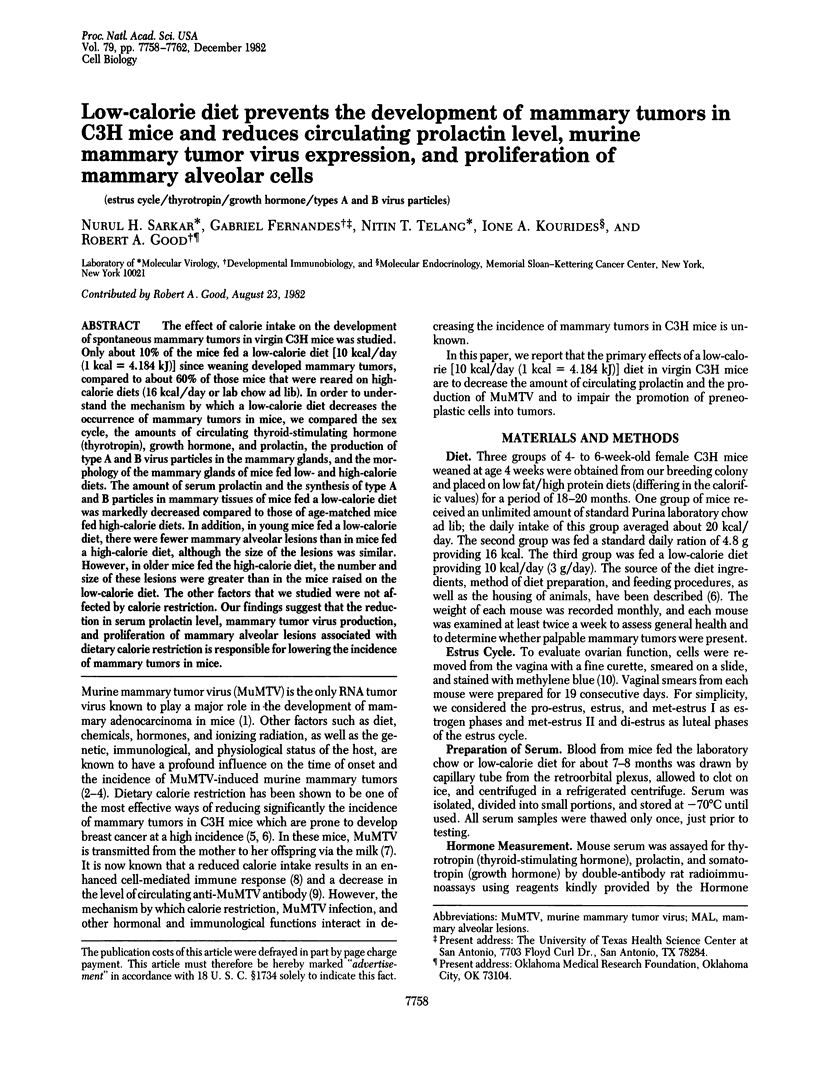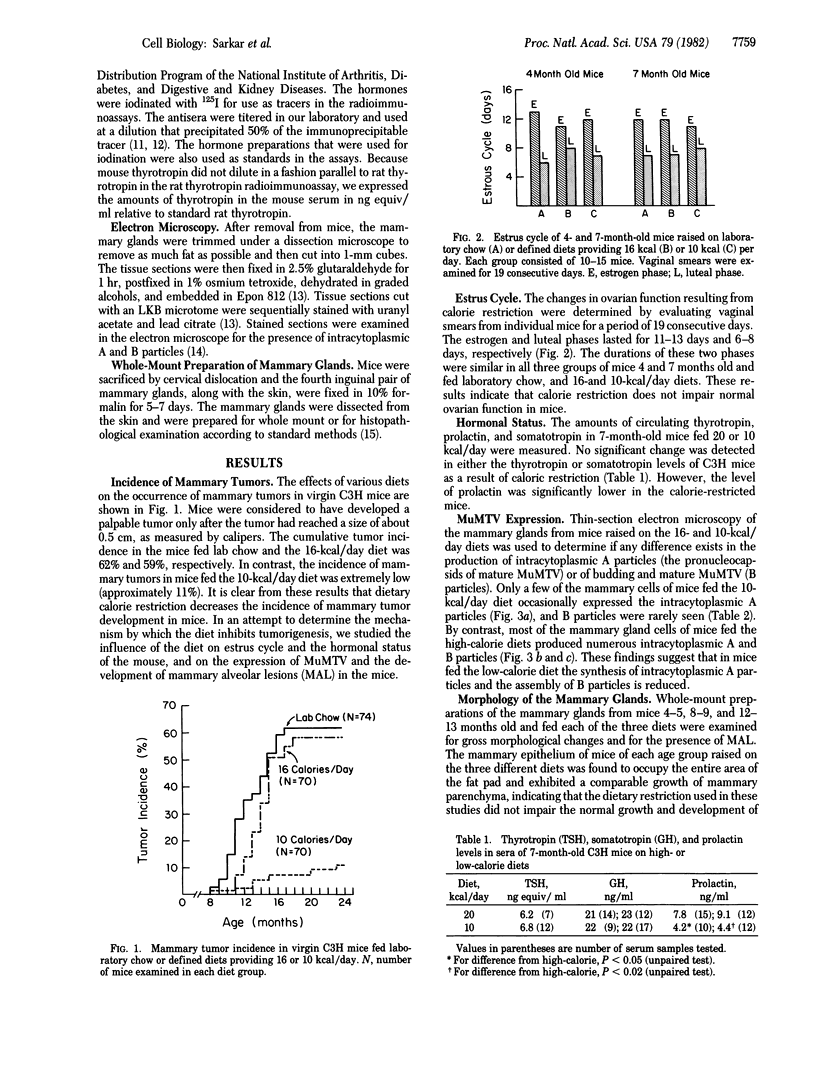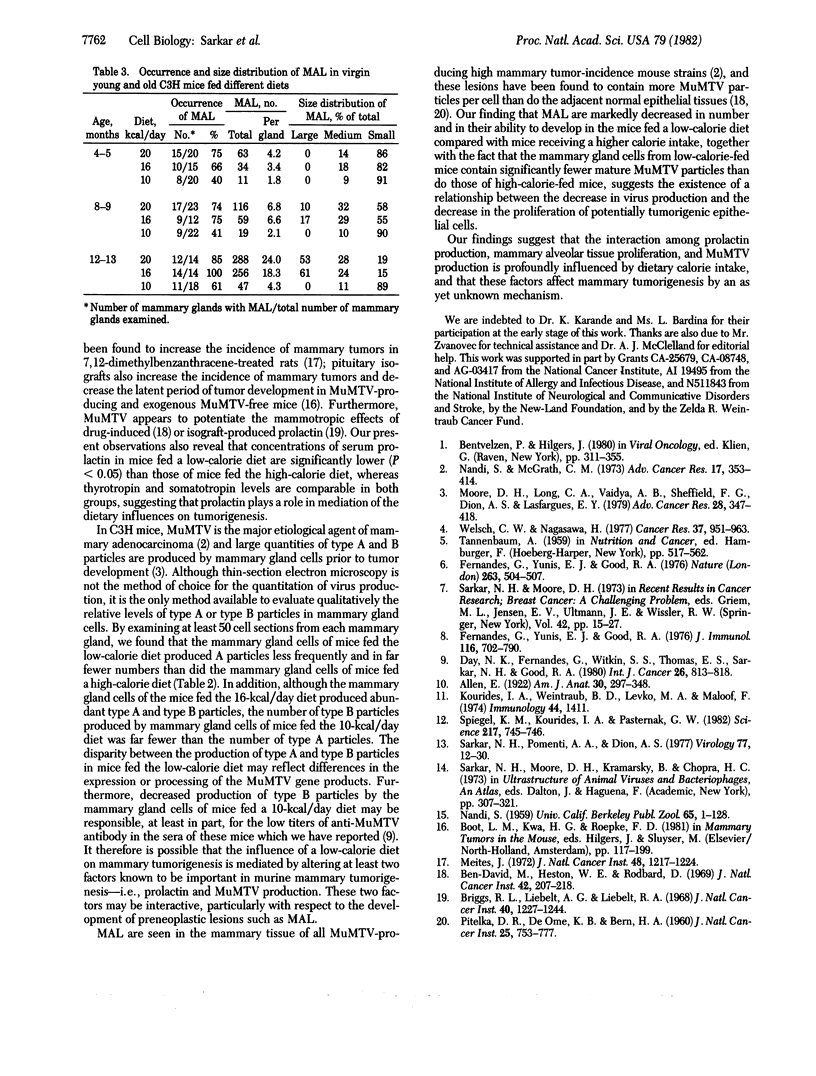Abstract
The effect of carlorie intake on the development of spontaneous mammary tumors in virgin C3H mice was studied. Only about 10% of the mice fed a low-calorie diet [10 kcal/day (1 kcal = 4.184 kJ)] since weaning developed mammary tumors, compared to about 60% of those mice that were reared on high-calorie diets (16 kcal/day or lab chow ad lib). In order to understand the mechanism by which a low-calorie diet decreases the occurrence of mammary tumors in mice, we compared the sex cycle, the amounts of circulating thyroid-stimulating hormone (thyrotropin), growth hormone, and prolactin, the production of type A and B virus particles in the mammary glands, and the morphology of the mammary glands of mice fed low- and high-calorie diets. The amount of serum prolactin and the synthesis of type A and B particles in mammary tissues of mice fed a low-calorie diet was markedly decreased compared to those of age-matched mice fed high-calorie diets. In addition, in young mice fed a low-calorie diet, there were fewer mammary alveolar lesions than in mice fed a high-calorie diet, although the size of the lesions was similar. However, in older mice fed the high-calorie diet, the number and size of these lesions were greater than in the mice raised on the low-calorie diet. The other factors that we studied were not affected by calorie restriction. Our findings suggest that the reduction in serum prolactin level, mammary tumor virus production, and proliferation of mammary alveolar lesions associated with dietary calorie restriction is responsible for lowering the incidence of mammary tumors in mice.
Keywords: estrus cycle, thyrotropin, growth hormone, types A and B virus particles
Full text
PDF




Images in this article
Selected References
These references are in PubMed. This may not be the complete list of references from this article.
- Ben-David M., Heston W. E., Rodbard D. Mammary tumor virus potentiation of endogenous prolactin effect on mammary gland differentiation. J Natl Cancer Inst. 1969 Feb;42(2):207–218. [PubMed] [Google Scholar]
- Briggs R. L., Liebelt A. G., Liebelt R. A. Systemic effects of hypophysial isografts in female inbred mice. J Natl Cancer Inst. 1968 Jun;40(6):1227–1244. [PubMed] [Google Scholar]
- Day N. K., Fernandes G., Witkin S. S., Thomas E. S., Sarkar N. H., Good R. A. The effect of diet on autogenous immunity to mouse mammary tumor virus in C3H/Bi mice. Int J Cancer. 1980 Dec 15;26(6):813–818. doi: 10.1002/ijc.2910260616. [DOI] [PubMed] [Google Scholar]
- Fernandes G., Yunis E. J., Good R. A. Influence of protein restriction on immune functions in NZB mice. J Immunol. 1976 Mar;116(3):782–790. [PubMed] [Google Scholar]
- Fernandes G., Yunis E. J., Good R. A. Suppression of adenocarcinoma by the immunological consequences of calorie restriction. Nature. 1976 Oct 7;263(5577):504–507. doi: 10.1038/263504b0. [DOI] [PubMed] [Google Scholar]
- Kourides I. A., Weintraub B. D., Levko M. A., Maloof F. Alpha and beta subunits of human thyrotropin: purification and development of specific radioimmunoassays. Endocrinology. 1974 May;94(5):1411–1421. doi: 10.1210/endo-94-5-1411. [DOI] [PubMed] [Google Scholar]
- Meites J. Relation of prolactin and estrogen to mammary tumorigenesis in the rat. J Natl Cancer Inst. 1972 Apr;48(4):1217–1224. [PubMed] [Google Scholar]
- Moore D. H., Long C. A., Vaidya A. B., Sheffield J. B., Dion A. S., Lasfargues E. Y. Mammary tumor viruses. Adv Cancer Res. 1979;29:347–418. doi: 10.1016/s0065-230x(08)60850-7. [DOI] [PubMed] [Google Scholar]
- PITELKA D. R., DEOME K. B., BERN H. A. Viruslike particles in precancerous hyperplastic mammary tissues of C3H and C3Hf mice. J Natl Cancer Inst. 1960 Oct;25:753–777. doi: 10.1093/jnci/25.4.753. [DOI] [PubMed] [Google Scholar]
- Sarkar N. H., Pomenti A. A., Dion A. S. Replication of mouse mammary tumor virus in tissue culture. 1. Establishment of a mouse mammary tumor cell line, virus characterization, and quantitation of virus production. Virology. 1977 Mar;77(1):12–30. doi: 10.1016/0042-6822(77)90402-0. [DOI] [PubMed] [Google Scholar]
- Spiegel K., Kourides I. A., Pasternak G. W. Prolactin and growth hormone release by morphine in the rat: different receptor mechanisms. Science. 1982 Aug 20;217(4561):745–747. doi: 10.1126/science.6285470. [DOI] [PubMed] [Google Scholar]
- Welsch C. W., Nagasawa H. Prolactin and murine mammary tumorigenesis: a review. Cancer Res. 1977 Apr;37(4):951–963. [PubMed] [Google Scholar]




